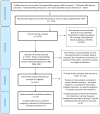Chlamydia trachomatis Screening and Treatment in Pregnancy to Reduce Adverse Pregnancy and Neonatal Outcomes: A Review
- PMID: 34178906
- PMCID: PMC8222807
- DOI: 10.3389/fpubh.2021.531073
Chlamydia trachomatis Screening and Treatment in Pregnancy to Reduce Adverse Pregnancy and Neonatal Outcomes: A Review
Abstract
Chlamydial trachomatis infection has been associated with adverse pregnancy and neonatal outcomes such as premature rupture of membranes, preterm birth, low birth weight, conjunctivitis, and pneumonia in infants. This review evaluates existing literature to determine potential benefits of antenatal screening and treatment of C. trachomatis in preventing adverse outcomes. A literature search revealed 1824 studies with 156 full-text articles reviewed. Fifteen studies were selected after fulfilling inclusion criteria. Eight studies focused on chlamydial screening and treatment to prevent adverse pregnancy outcomes such as premature rupture of membranes, preterm birth, low birth weight, growth restriction leading to small for gestational age infants, and neonatal death. Seven studies focused on the effects of chlamydial screening and treatment on adverse infant outcomes such as chlamydial infection including positive mucosal cultures, pneumonia, and conjunctivitis. Given the heterogeneity of those studies, this focused review was exclusively qualitative in nature. When viewed collectively, 13 of 15 studies provided some degree of support that antenatal chlamydial screening and treatment interventions may lead to decreased adverse pregnancy and infant outcomes. However, notable limitations of these individual studies also highlight the need for further, updated research in this area, particularly from low and middle-income settings.
Keywords: Chlamydia trachomatis; adverse pregnancy outcomes; infant outcomes; pregnancy; sexually transmitted infections.
Copyright © 2021 Adachi, Nielsen-Saines and Klausner.
Conflict of interest statement
The authors declare that the research was conducted in the absence of any commercial or financial relationships that could be construed as a potential conflict of interest.
Figures
Similar articles
-
Chlamydia trachomatis infection during pregnancy.Am J Obstet Gynecol. 1991 Jun;164(6 Pt 2):1782-9. doi: 10.1016/0002-9378(91)90560-e. Am J Obstet Gynecol. 1991. PMID: 2039032 Review.
-
Chlamydia trachomatis and Adverse Pregnancy Outcomes: Meta-analysis of Patients With and Without Infection.Matern Child Health J. 2018 Jun;22(6):812-821. doi: 10.1007/s10995-018-2451-z. Matern Child Health J. 2018. PMID: 29417367
-
Effect of Chlamydia trachomatis on adverse pregnancy outcomes: a meta-analysis.Arch Gynecol Obstet. 2020 Sep;302(3):553-567. doi: 10.1007/s00404-020-05664-6. Epub 2020 Jul 8. Arch Gynecol Obstet. 2020. PMID: 32643040 Review.
-
Chlamydia trachomatis infection in a sample of northern Brazilian pregnant women: prevalence and prenatal importance.Braz J Infect Dis. 2013 Sep-Oct;17(5):545-50. doi: 10.1016/j.bjid.2013.01.014. Epub 2013 Jul 4. Braz J Infect Dis. 2013. PMID: 23831212 Free PMC article.
-
Chlamydia trachomatis Infection in Pregnancy: The Global Challenge of Preventing Adverse Pregnancy and Infant Outcomes in Sub-Saharan Africa and Asia.Biomed Res Int. 2016;2016:9315757. doi: 10.1155/2016/9315757. Epub 2016 Apr 6. Biomed Res Int. 2016. PMID: 27144177 Free PMC article. Review.
Cited by
-
Identifying the Impact of Chlamydia trachomatis Screening and Treatment on Mother-to-Child Transmission, and Respiratory Neonatal Outcomes in Mexico.Pathogens. 2024 Sep 28;13(10):843. doi: 10.3390/pathogens13100843. Pathogens. 2024. PMID: 39452715 Free PMC article.
-
Maternal-fetal transfer and longitudinal trends of antibodies to Chlamydia trachomatis and Mycoplasma genitalium in early childhood.Acta Obstet Gynecol Scand. 2025 Jul;104(7):1366-1372. doi: 10.1111/aogs.15105. Epub 2025 May 12. Acta Obstet Gynecol Scand. 2025. PMID: 40356080 Free PMC article.
-
Chlamydia Peritonitis Mimicking Juvenile Carcinomatous Peritonitis Diagnosed by Exploratory Laparoscopy: A Case Report.Pathogens. 2023 Jan 6;12(1):94. doi: 10.3390/pathogens12010094. Pathogens. 2023. PMID: 36678442 Free PMC article.
-
Evaluating the impact and cost-effectiveness of chlamydia management strategies in Hong Kong: A modeling study.Front Public Health. 2022 Jul 27;10:932096. doi: 10.3389/fpubh.2022.932096. eCollection 2022. Front Public Health. 2022. PMID: 35968473 Free PMC article.
-
The Polymorphic Membrane Protein G Has a Neutral Effect and the Plasmid Glycoprotein 3 an Antagonistic Effect on the Ability of the Major Outer Membrane Protein to Elicit Protective Immune Responses against a Chlamydia muridarum Respiratory Challenge.Vaccines (Basel). 2023 Feb 21;11(3):504. doi: 10.3390/vaccines11030504. Vaccines (Basel). 2023. PMID: 36992088 Free PMC article.
References
-
- World Health Organization . Global Incidence and Prevalence of Selected Curable Sexually Transmitted Infections−2008. Geneva: World Health Organization; (2012).
-
- Newman L, Rowley J, Vander Hoorn S, Wijesooriya NS, Unemo M, Low N, et al. . Global estimates of the prevalence and incidence of four curable sexually transmitted infections in 2012. Based on systematic review and global reporting. PLoS ONE. (2015) 10:e0143304. 10.1371/journal.pone.0143304 - DOI - PMC - PubMed
-
- Joseph Davey DL, Shull HI, Billings JD, Wang D, Adachi K, Klausner JD. Prevalence of curable sexually transmitted infections in pregnant women in low- and middle-income countries from 2010 to 2015: a systematic review. Sex Transm Dis. (2016) 43:450–8. 10.1097/OLQ.0000000000000460 - DOI - PMC - PubMed


